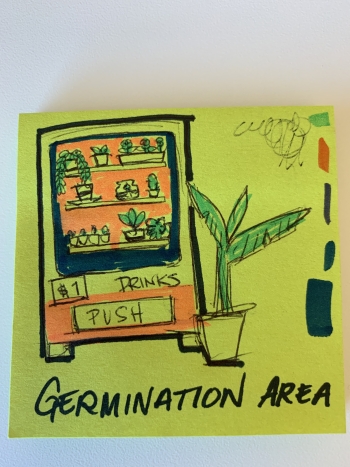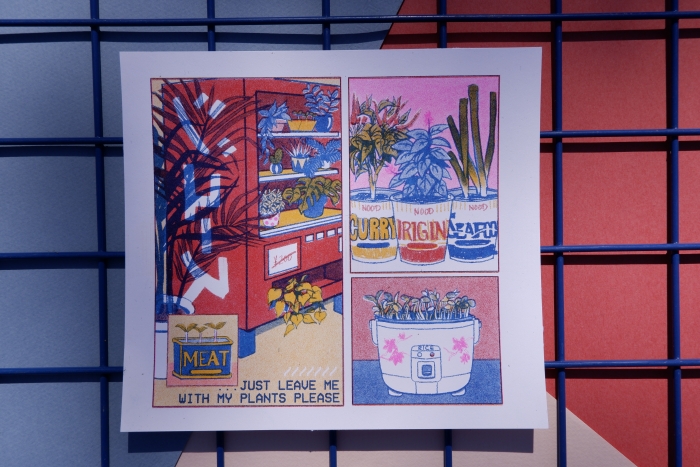Sun Devil wins world-building competition with game that imagines a better future

ASU animation student Victoria Silva (left) and Vedika Bhasin, an augmented reality artist based in the San Francisco Bay area, both won a $60,000 scholarship to graduate school at ASU in the Worlds for Change Challenge announced recently at the SXSW 20 fest in Austin, Texas.
An Arizona State University student has won a scholarship for graduate school by designing an extended-reality game that reimagines the landscape of her native Guam.
Victoria Silva, an animation major in the School of Art who was one of two Worlds for Change grand prize winners, created “Leeward,” a 3D gardening game about conservation and identity from an indigenous perspective.
The other winner is Vedika Bhasin, an augmented reality artist based in the San Francisco Bay area who designed “Grok,” an extended-reality experience from the perspective of someone with attention-deficit/hyperactivity disorder, with the goal of understanding neurodivergence.
Both artists won a $60,000 scholarship to attend one of ASU’s transdisciplinary extended-reality graduate degree programs at the MIX Center in Mesa or at the ASU California Center Broadway in downtown Los Angeles.
The Herberger Institute for Design and the Arts launched the Worlds for Change Challenge last September, asking artists to create a virtual world illustrating a positive future. The competition was open to any current or recently completed undergraduate student or early-career professional.
Competitors followed this prompt: “Show us a moment of everyday life in the future from a world that you would like to see.”
The winners were announced recently at the SXSW 24 festival in Austin, Texas.
Silva knew about the competition and attended the kickoff event in September, but didn’t think she had any ideas that could change the world. She played around and realized that she had already done much of the work necessary.
“I did the world building on 'Leeward' until I reached the point where I couldn’t work on it anymore. I needed to execute it, but I didn’t have the technical skills,” she said.
So she took an eight-week crash course on how to use the Unreal engine through Code Coven, a coding academy for game developers from marginalized communities.
Silva is CHamoru, an Indigenous person from the island of Guam, a U.S. territory where she was born and raised. Her family moved away 16 years ago.
“One day at my job I was doodling this little concept, ‘What if there was a little place to germinate plants and what if we repurposed things and repaired things?’
“The experience of the game is repairing and rejuvenating the island after the effects of climate change and colonialism and tourism overload,” she said.
“It’s an opportunity to talk about the struggles and things that Pacific Islanders encounter when they’ve moved away and want to reconnect with their island.”
Silva said that, for many people, their only knowledge of Guam is from its history as a battle site during World War II.
“I wanted the narrative to be more positive,” she said.
She started collecting old photos of different spots in Guam and comparing them with modern photos of the same place. She came across an old photo album on eBay from the 1950s, when a military family was based on Guam.
“There were photos I hadn’t seen before, and one was of a bungalow, which was the first thing I 3D modeled in the game,” she said. She made the bungalow into a greenhouse.
In the game, the player is an islander who returns for their grandmother's funeral after having spent time away. The player can restore parts of the island through gardening and other actions. Some of the tasks are cultural, such as restoring a mural.
"Leeward" includes weather and natural disasters, like typhoons, volcanos, earthquakes and invasive plant and animal species, as well as real settings, such as the beach, jungle, village and a sacred area that’s been used as a military zone.
The game is not ready for release yet.
“It’s still an early concept, and I’ll work on it as my applied project for the extended arts degree program,” said Silva, who expects to complete her BFA in December.
Silva is already a working artist. She’s part of SaturnHex, a two-person independent art studio in Phoenix focused on illustration and design through silkscreen and risograph printing, and she also teaches screen printing.
“I’m interested in continuing to teach, especially if it’s related to the work I’m doing in making games and storytelling and world building,” she said.
“Even though the project is very focused on an experience of someone from the Pacific and an islander, I hope it’s a game that everyone can learn from and enjoy.”
The Worlds for Change Challenge had several sponsors and partnersThe sponsors were the School for the Future of Innovation in Society, the ASU Thunderbird School of Global Management, the Center for Science and the Imagination, ASU Narrative and Emerging Media, The Luminosity Lab, Dreamscape Learn and the Nemesis Club. Presenting sponsors were Intel+Lenovo, Pixera/AV Stumpfl, Planar/Optitrack and Volvox Labs. Partners were ASU MEDIAted eXperiences Lab, ASU METEOR Studio, Games for Change, Our Future Life and Brelyon. .
More Arts, humanities and education
ASU film professor part of 'Cyberpunk' exhibit at Academy Museum in LA
Arizona State University filmmaker Alex Rivera sees cyberpunk as a perfect vehicle to represent the Latino experience.Cyberpunk is a subgenre of science fiction that explores the intersection of…

Honoring innovative practices, impact in the field of American Indian studies
American Indian Studies at Arizona State University will host a panel event to celebrate the release of “From the Skin,” a collection over three years in the making centering stories, theories and…

ASU alum's humanities background led to fulfilling job with the governor's office
As a student, Arizona State University alumna Sambo Dul was a triple major in Spanish, political science and economics. After graduating, she leveraged the skills she cultivated in college —…

